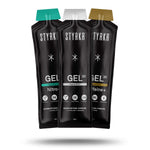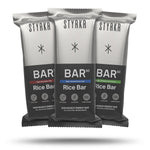Add these stretches to your routine and beat knee pain for good.
 If you have been experiencing knee pain when running, you know how frustrating it can be.
If you have been experiencing knee pain when running, you know how frustrating it can be.
All you want to do is run — but your knee has other ideas. It can be painful and, if not addressed, can cause further problems like poor patella tracking and incorrect running mechanics to compensate for the pain.
I spoke to Zach Smith, founder and doctor of physical therapy at HIDEF Physical Therapy, for the best knee stretches for runners to help you beat knee pain for good.
Here are six of the best knee stretches for running:
1. Kneeling quad stretch

The first stretch is excellent for stretching the quads because it targets all four heads, including the rectus femoris, which is usually not stretched unless you go into full hip extension, explains Smith.
A tight rectus femoris can pull on the patella (kneecap) and increase joint pressure when running.
This can contribute to knee pain and strain on the knee joint.
How to perform:
-
Start in a kneeling position while keeping your back straight
-
Place your palms behind your body, wider than shoulder width and lean back until you feel a deep stretch (you should be sitting on your ankles)
-
Hold this position for 30-60 seconds and repeat 2-3 times
2. Walking dynamic hamstring stretch

The walking dynamic hamstring stretch is great before a run to get the hamstrings loose.
“I add this in with all of my athletes prior to any lower body, including running,” says Smith.
How to perform:
-
Stand tall and take a small step forward with your right leg, keeping it straight and your heel on the ground.
-
Hinge at the hips and reach one hand (same as the foot in front of the body) and touch your toes — keep your back flat.
-
You should feel a stretch in the back of your right thigh (pause briefly).
-
Step forward with your left leg and repeat the movement, alternating sides as you walk.
3. Walking quad stretch

The walking quad stretch is one you don’t see quite so often.
Most runners and athletes choose the seated or standing version without the added dynamic movement.
You can add reach above your head to fully extend the body, creating a much deeper stretch.
How to perform:
-
Stand tall and take a step forward with your right leg. As you step, bend your left knee and grab your left ankle or foot behind you with your left hand.
-
Gently pull your heel toward your glutes while keeping your knees close together and your torso upright.
At the same time, reach your right arm overhead for a full-body stretch, then release and step forward, repeating on the other side.
4. Walking single knee to chest stretch

This simple stretch can help improve hip mobility and alleviate tight hip flexors and glutes, which can cause stress on the knee joints.
It also requires balance and coordination and activates key stabilisers, improving neuromuscular control and reinforcing proper stride mechanics.
Do the walking single knee to chest stretch before a run or as part of a daily mobility routine to counteract tight hips from sitting.
How to perform:
-
Stand tall and take a small step forward with your right leg.
-
Lift your left knee toward your chest, using both hands to gently pull it in closer.
-
Pause briefly while balancing on your right leg, keeping your torso upright and core engaged.
-
Release and step forward, repeating on the other side as you walk.
5. Kneeling quad stretch with foot on bench

Also called the couch stretch, the kneeling quad stretch with a foot on a bench allows for a much deeper stretch than the regular sitting or standard variation.
It targets the quadriceps muscles, including the rectus femoris.
Add this stretch to your stretching and mobility routine to improve hip extension and release tension on the kneecap. You can also do this stretch after a run to relieve tight quads.
How to perform:
-
Start in a lunge position with your back knee touching the floor and your back foot resting on a bench or box behind you.
-
Keep your front knee bent at 90 degrees and your torso upright.
-
Engage your glutes and gently push your hips forward until you feel a stretch in the front of your thigh and hip.
-
Hold the stretch for 30–60 seconds, then switch sides.
6. Calf stretch step through

Many people don’t realise that the calf muscles connect all the up behind the knee, explains Smith.
He recommends stretching the calf muscles before running to alleviate some pressure off the knees.
Additionally, Smith explains that the more ankle mobility you have, the less stress goes through the knees. The calf stretch will also help improve your ankle mobility.
How to perform:
-
Stand in a staggered stance with your right foot forward and left foot back, both feet flat on the ground.
Bend your right knee and lean forward, keeping your left leg straight and heel pressed into the floor. -
You should feel a stretch in your left calf — hold briefly.
-
Step forward into the next lunge and repeat the stretch on the opposite side as you walk.
You may find it useful to use a yoga block when performing this exercise.
A few notes on recovery
Please note: this article is not medical advice. See a physical therapist or your doctor if you are suffering from knee pain.
Also, nutrition plays a crucial role when recovering from an injury, like runner’s knee. Your body needs the right nutrients to repair damaged tissues, rebuild strength — when paired with resistance training — and support connective tissue repair.
Shop STYRKR recovery bars to support your recovery and training demands.

